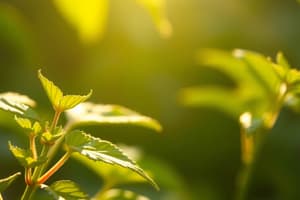Podcast
Questions and Answers
Where does the light-dependent reactions of photosynthesis take place?
Where does the light-dependent reactions of photosynthesis take place?
- Thylakoid membrane (correct)
- Stroma
- Nucleus
- Chloroplasts
What is the main purpose of the light-dependent reactions in photosynthesis?
What is the main purpose of the light-dependent reactions in photosynthesis?
- To convert solar energy into chemical energy (correct)
- To build carbohydrate molecules
- To convert stored chemical energy into ATP
- To convert CO2 into glucose
What is the function of RuBisCO in the Calvin cycle?
What is the function of RuBisCO in the Calvin cycle?
- Converts sunlight into chemical energy
- Regenerates sugar molecules
- Harvests energy from sunlight
- Combines CO2 with RuBP (correct)
Where does the light-independent reactions (Calvin cycle) take place?
Where does the light-independent reactions (Calvin cycle) take place?
What is the primary product of the light-independent reactions?
What is the primary product of the light-independent reactions?
What are the energy carriers produced during the light-dependent reactions used for?
What are the energy carriers produced during the light-dependent reactions used for?
What is the main function of the Calvin cycle in photosynthesis?
What is the main function of the Calvin cycle in photosynthesis?
What happens to the remaining G3P molecules in the Calvin cycle?
What happens to the remaining G3P molecules in the Calvin cycle?
Which stage of photosynthesis absorbs and converts solar energy into chemical energy?
Which stage of photosynthesis absorbs and converts solar energy into chemical energy?
What is the primary function of ATP and NADPH in photosynthesis?
What is the primary function of ATP and NADPH in photosynthesis?
What allows plants to access energy from the sun and store it in the form of carbohydrates for later use?
What allows plants to access energy from the sun and store it in the form of carbohydrates for later use?
What is the role of plants' ability to function with both photosynthesis and respiration?
What is the role of plants' ability to function with both photosynthesis and respiration?
Study Notes
Making Carbohydrates Using Light Energy: Photosynthesis and Light-Dependent Reactions
Photosynthesis is a process that converts solar energy into chemical energy, which is then used to build carbohydrate molecules, most commonly glucose. This process occurs in chloroplasts and involves two sequential stages: the light-dependent reactions and the light-independent reactions (also known as the Calvin cycle).
Light-Dependent Reactions
During the light-dependent reactions, energy from sunlight is absorbed by chlorophyll and converted into stored chemical energy, such as ATP and NADPH. These energy carriers are used to power the reactions of the Calvin cycle. The light-dependent reactions take place at the thylakoid membrane, where chlorophyll absorbs energy from sunlight and converts it into chemical energy.
Light-Independent Reactions (Calvin Cycle)
In the light-independent reactions, the chemical energy harvested during the light-dependent reactions drives the assembly of sugar molecules. The Calvin cycle can be organized into three basic stages: fixation, reduction, and regeneration.
- Fixation: In the stroma, an enzyme called ribulose-1,5-bisphosphate carboxylase/oxygenase (RuBisCO) combines CO2 with another molecule, ribulose bisphosphate (RuBP).
- Reduction: The energy contained in ATP and NADPH is used to convert the three-carbon compound RuBP into a six-carbon compound, which is then broken down into two three-carbon compounds.
- Regeneration: The remaining G3P molecules stay in the cycle to be formed back into RuBP, which is then ready to react with more CO2.
Photosynthesis forms an energy cycle with the process of cellular respiration, allowing organisms to access life-sustaining energy that originates millions of miles away in a star. Plants need both photosynthesis and respiration for their ability to function in both the light and to interconvert essential metabolites.
In summary, the process of making carbohydrates using light energy involves two stages: the light-dependent reactions, which absorb and convert solar energy into chemical energy, and the light-independent reactions (Calvin cycle), which use the energy stored in ATP and NADPH to build carbohydrate molecules. This biological process allows plants and other photosynthetic organisms to access energy from the sun and store it in the form of carbohydrates for later use.
Studying That Suits You
Use AI to generate personalized quizzes and flashcards to suit your learning preferences.
Description
Explore the process of converting solar energy into chemical energy during photosynthesis, including the light-dependent reactions that generate energy carriers and the light-independent reactions (Calvin cycle) that assemble sugar molecules. Learn about the stages of the Calvin cycle and the significance of photosynthesis in producing carbohydrates using light energy.




